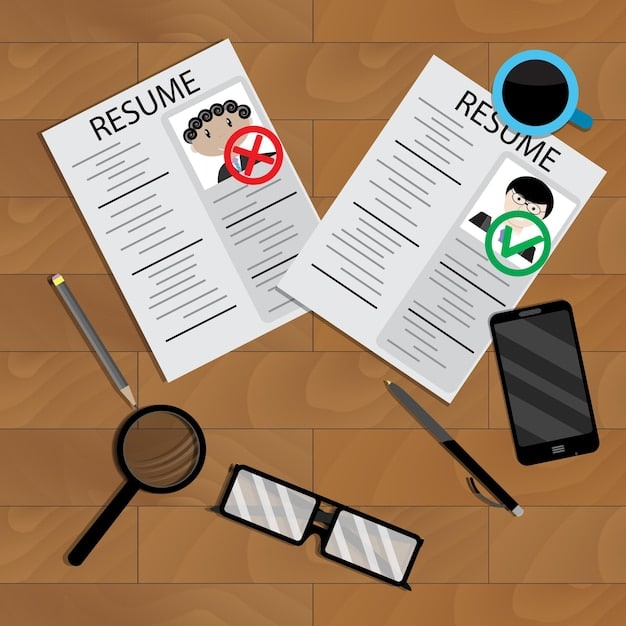The Essential Guide to Writing a Resume That Gets You Noticed in 2025

The Essential Guide to Writing a Resume That Gets You Noticed in 2025 provides strategies for creating a compelling resume, emphasizing skills, achievements, and formatting to capture recruiters’ attention in the competitive job market of 2025.
Crafting a standout resume is crucial for landing your dream job. In 2025, where competition is fierce, you need more than just a list of past experiences; you need a compelling story that highlights your unique value. This The Essential Guide to Writing a Resume That Gets You Noticed in 2025 will provide you with the strategies and tools to create a resume that grabs attention and leads to interviews.
Understanding the 2025 Job Market and Resume Trends
The job market is constantly evolving, and in 2025, certain trends are becoming increasingly important. Understanding these trends will help you tailor your resume to meet the demands of recruiters and hiring managers.
The Rise of AI and Automation
Artificial intelligence (AI) is playing a significant role in the hiring process. Many companies use Applicant Tracking Systems (ATS) to screen resumes. These systems scan for keywords and specific qualifications before a human even looks at your application.
Emphasis on Soft Skills
While technical skills remain important, employers are placing greater emphasis on soft skills such as communication, problem-solving, and adaptability. Your resume should showcase these skills through quantifiable achievements and specific examples.

Here are some trends to keep in mind:
- Remote Work Experience: Highlight any experience you have working remotely, including your ability to collaborate effectively in a virtual environment.
- Data Literacy: Demonstrate your ability to analyze data and use it to inform decision-making.
- Personal Branding: Your resume is a key part of your personal brand. Ensure it reflects your unique value proposition and aligns with your online presence.
Knowing the pulse of the 2025 job market enables you to create a resume that meets current expectations and shows you’re prepared for what’s ahead with future employment opportunities.
Choosing the Right Resume Format for 2025
Selecting the appropriate resume format is critical to ensure your qualifications are presented effectively. There are three main formats to consider, each suited to different career stages and industries.
Chronological Resume
A chronological resume lists your work experience in reverse chronological order, starting with your most recent job. This format is ideal if you have a consistent work history and want to highlight your career progression.
Functional Resume
A functional resume focuses on your skills and abilities rather than your work history. It’s a good choice if you have gaps in your employment or are changing careers.
Combination Resume
A combination resume blends elements of both chronological and functional formats. It allows you to showcase your skills while also providing a clear timeline of your work experience.
Consider these aspects when picking your format:
- Job Level: Entry-level positions may benefit from a functional format, while senior roles often require a chronological approach.
- Industry Standards: Research common resume formats in your industry to align with employer expectations.
- Personal Strengths: If your strengths lie in specific skill sets, a functional or combination resume may be more effective.
Choosing the right format helps highlight your relevant experience and attract the recruiter’s eye.
Crafting Compelling Resume Sections
Beyond the format, each section of your resume should be tailored to grab attention and highlight your qualifications. A well-crafted resume clearly communicates your value proposition to potential employers.
Heading and Contact Information
Start with a clear and concise heading that includes your full name, phone number, email address, and LinkedIn profile URL. Ensure this information is accurate and professional.
Summary or Objective Statement
A summary statement provides a brief overview of your skills and experience, while an objective statement outlines your career goals. Choose the one that best aligns with your career stage and the role you’re applying for. A summary works well for those with experience, providing a snapshot of accomplishments, while an objective can be useful for entry-level candidates or those changing careers, sharing immediate career goals.

Remember to include:
- Quantifiable Achievements: Use numbers and data to demonstrate the impact of your work.
- Keywords: Incorporate relevant keywords from the job description to help your resume pass through ATS systems.
- Action Verbs: Start your bullet points with strong action verbs to describe your responsibilities and accomplishments.
Crafting each section with detail and care highlights your value and showcases your capabilities, making your resume stand out.
Showcasing Your Skills and Achievements
The skills and achievements section is where you demonstrate your capabilities and prove your value to potential employers. Showcase a mix of hard and soft skills that align with the job requirements.
Highlighting Technical Skills
Technical skills are specific abilities related to your field. List them clearly, along with any relevant certifications or training.
Demonstrating Soft Skills
Soft skills are interpersonal abilities such as communication, teamwork, and problem-solving. Provide examples of how you’ve used these skills to achieve results.
Here’s how to make an effective skill section:
- Prioritize Relevance: Focus on skills that are most relevant to the job description.
- Use Quantifiable Metrics: Whenever possible, quantify your achievements with numbers and data.
- Provide Context: Explain how you’ve used your skills in specific situations.
By providing solid information and achievements you create a convincing narrative of your abilities.
Optimizing Your Resume for ATS and Search Engines
Applicant Tracking Systems (ATS) are used by many companies to screen resumes. Optimizing your resume for ATS and search engines ensures it gets seen by the right people.
Keyword Research
Identify the keywords that are most relevant to your industry and the jobs you’re applying for. Use these keywords throughout your resume, especially in your skills and experience sections.
Formatting for ATS
Use a simple, clean format that is easy for ATS systems to parse. Avoid using tables, images, or special characters that can confuse the system.
To avoid being overlooked by automated systems and make your resume easily accessible:
- Use Standard Fonts: Stick to common fonts like Arial, Calibri, or Times New Roman.
- Save as PDF: Save your resume as a PDF to preserve formatting and ensure compatibility with different systems.
- Avoid Headers and Footers: ATS systems may not be able to read information in headers and footers.
Optimizing your resume for ATS means that even if the machines are reading your application, human eyes are sure to see the value in your experience.
Proofreading and Final Touches
Before submitting your resume, it’s essential to proofread it carefully and make any necessary revisions. A polished resume demonstrates attention to detail and professionalism.
Checking for Errors
Look for typos, grammatical errors, and inconsistencies in formatting. Use a tool like Grammarly or ask a friend to review your resume.
Seeking Feedback
Get feedback from career counselors, mentors, or colleagues. They can provide valuable insights and help you identify areas for improvement.
A few final considerations before sending your resume:
- Tailor to Each Job: Customize your resume for each job you apply for, highlighting the skills and experiences that are most relevant to the position.
- Keep it Concise: Aim for a one-page resume, especially if you have less than 10 years of experience.
- Update Regularly: Keep your resume up-to-date with your latest skills, achievements, and work experience.
With a polished resume you’ll stand out from the crowd because you’ve taken the details seriously, which recruiters will appreciate.
| Key Element | Brief Description |
|---|---|
| 🎯 Targeted Skills | Focus on skills that directly match job descriptions, enhancing relevance. |
| 📊 Quantifiable Results | Use metrics and data to show the impact of your work. |
| ✍️ ATS Optimization | Ensure your resume is readable by ATS with keywords and standard formatting. |
| ✨ Clean Presentation | Keep your resume clear, concise, and easy to scan to make an impact. |
Frequently Asked Questions
▼
Tailoring your resume is crucial because it shows employers you understand and meet their specific needs. It increases your chances of passing through Applicant Tracking Systems (ATS) and grabbing the hiring manager’s attention.
▼
If you have limited work experience, focus on showcasing relevant skills, education, volunteer work, and extracurricular activities. Highlight any projects, internships, or achievements that demonstrate your abilities and potential.
▼
Ideally, your resume should be one page if you have less than 10 years of experience. If you have extensive experience, a two-page resume is acceptable, but keep it concise and relevant to the job.
▼
Common mistakes include typos, grammatical errors, generic summaries, irrelevant information, and poor formatting. Always proofread carefully and tailor your resume to the specific job requirements to avoid these issues.
▼
In the United States, it is generally not recommended to include a photo on your resume unless you’re in an industry where it’s standard practice, such as acting or modeling. Focus on your qualifications and experience instead.
Conclusion
Creating a resume that stands out in 2025 requires a strategic approach that combines current trends with proven best practices. By understanding the job market, choosing the right format, crafting compelling sections, showcasing skills, optimizing for ATS, and perfecting the final touches, you can create a resume that captures the attention of recruiters and hiring managers.





